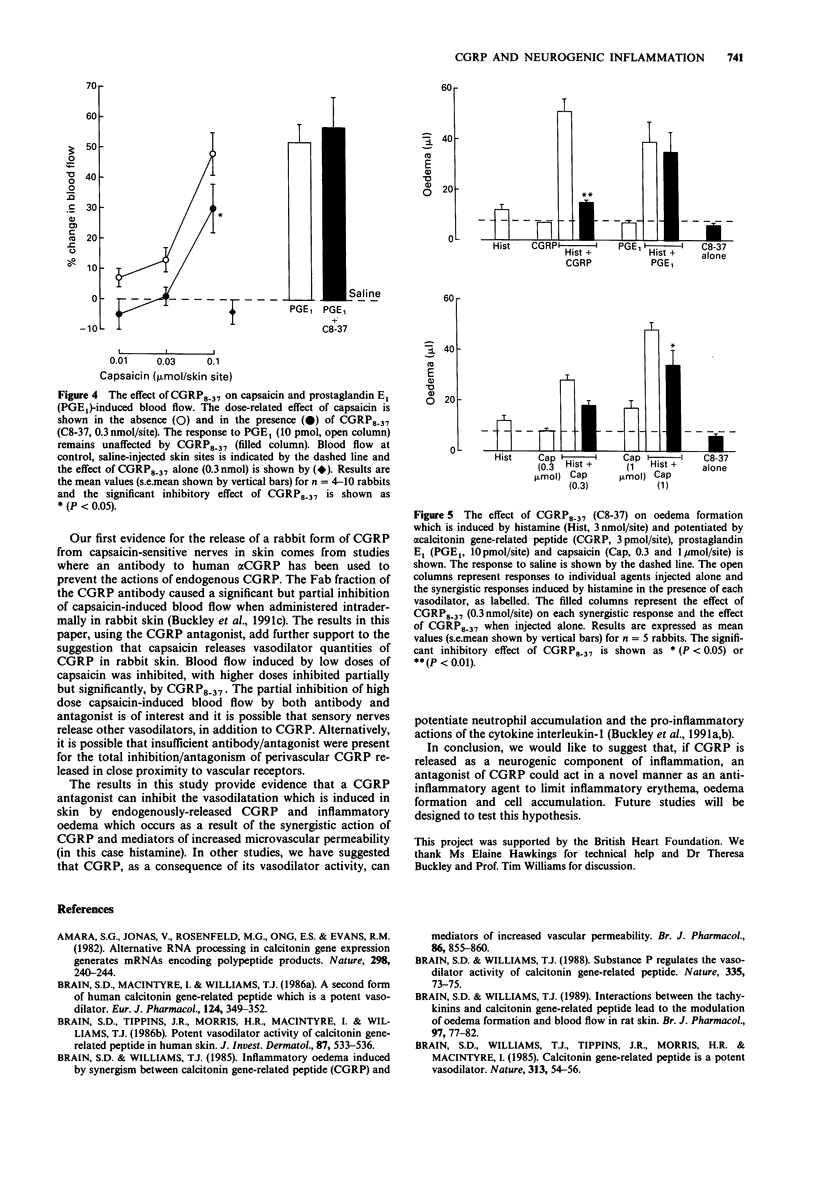Abstract
1. The effect of the calcitonin gene-related peptide (CGRP) antagonist CGRP8-37 on responses to CGRP and other mediators was investigated in rabbit dorsal skin. 2. Blood flow changes at intradermally-injected sites were measured by a multiple site 133xenon clearance technique. CGRP8-37 had little effect on blood flow at doses up to 0.3 nmol/site, when injected alone, although a significant increase in blood flow was observed at the highest dose tested (1 nmol/site). 3. CGRP8-37 dose-dependently inhibited the increased blood flow induced by human alpha CGRP and human beta CGRP, but had no effect on equivalent vasodilator responses induced by vasoactive intestinal peptide (VIP) and prostaglandin E1 (PGE1). CGRP8-37 showed a preferential ability to inhibit alpha CGRP (IC50 0.04 nmol), when compared with beta CGRP (IC50 greater than or equal to 0.3 nmol). 4. Capsaicin, which selectively activates sensory nerves, caused a dose-dependent increase in blood flow when injected intradermally into rabbit skin. The effects of capsaicin (0.01-0.1 mumol/site) were inhibited by CGRP8-37 (0.3 nmol/site), with a partial but significant attenuation of blood flow induced by the highest dose of capsaicin. 5. Oedema formation, induced by intradermal histamine injection (3 nmol/site), was measured in rabbit skin by the local accumulation of intravenously-injected 125I-labelled albumin. Vasodilator doses of CGRP, PGE1 and capsaicin potentiated, in a synergistic manner, oedema formation induced by histamine. GRP8-37 totally inhibited the potentiating effect of CGRP, partially inhibited the synergistic effect of capsaicin, but did not affect PGE1-induced responses.(ABSTRACT TRUNCATED AT 250 WORDS)
Full text
PDF




Selected References
These references are in PubMed. This may not be the complete list of references from this article.
- Amara S. G., Jonas V., Rosenfeld M. G., Ong E. S., Evans R. M. Alternative RNA processing in calcitonin gene expression generates mRNAs encoding different polypeptide products. Nature. 1982 Jul 15;298(5871):240–244. doi: 10.1038/298240a0. [DOI] [PubMed] [Google Scholar]
- Brain S. D., MacIntyre I., Williams T. J. A second form of human calcitonin gene-related peptide which is a potent vasodilator. Eur J Pharmacol. 1986 May 27;124(3):349–352. doi: 10.1016/0014-2999(86)90238-4. [DOI] [PubMed] [Google Scholar]
- Brain S. D., Tippins J. R., Morris H. R., MacIntyre I., Williams T. J. Potent vasodilator activity of calcitonin gene-related peptide in human skin. J Invest Dermatol. 1986 Oct;87(4):533–536. doi: 10.1111/1523-1747.ep12455620. [DOI] [PubMed] [Google Scholar]
- Brain S. D., Williams T. J. Inflammatory oedema induced by synergism between calcitonin gene-related peptide (CGRP) and mediators of increased vascular permeability. Br J Pharmacol. 1985 Dec;86(4):855–860. doi: 10.1111/j.1476-5381.1985.tb11107.x. [DOI] [PMC free article] [PubMed] [Google Scholar]
- Brain S. D., Williams T. J. Interactions between the tachykinins and calcitonin gene-related peptide lead to the modulation of oedema formation and blood flow in rat skin. Br J Pharmacol. 1989 May;97(1):77–82. doi: 10.1111/j.1476-5381.1989.tb11926.x. [DOI] [PMC free article] [PubMed] [Google Scholar]
- Brain S. D., Williams T. J. Substance P regulates the vasodilator activity of calcitonin gene-related peptide. Nature. 1988 Sep 1;335(6185):73–75. doi: 10.1038/335073a0. [DOI] [PubMed] [Google Scholar]
- Brain S. D., Williams T. J., Tippins J. R., Morris H. R., MacIntyre I. Calcitonin gene-related peptide is a potent vasodilator. Nature. 1985 Jan 3;313(5997):54–56. doi: 10.1038/313054a0. [DOI] [PubMed] [Google Scholar]
- Brain S. D., Wimalawansa S., MacIntyre I., Williams T. J. The demonstration of vasodilator activity of pancreatic amylin amide in the rabbit. Am J Pathol. 1990 Mar;136(3):487–490. [PMC free article] [PubMed] [Google Scholar]
- Buckley T. L., Brain S. D., Collins P. D., Williams T. J. Inflammatory edema induced by interactions between IL-1 and the neuropeptide calcitonin gene-related peptide. J Immunol. 1991 May 15;146(10):3424–3430. [PubMed] [Google Scholar]
- Buckley T. L., Brain S. D., Rampart M., Williams T. J. Time-dependent synergistic interactions between the vasodilator neuropeptide, calcitonin gene-related peptide (CGRP) and mediators of inflammation. Br J Pharmacol. 1991 Jun;103(2):1515–1519. doi: 10.1111/j.1476-5381.1991.tb09819.x. [DOI] [PMC free article] [PubMed] [Google Scholar]
- Chiba T., Yamaguchi A., Yamatani T., Nakamura A., Morishita T., Inui T., Fukase M., Noda T., Fujita T. Calcitonin gene-related peptide receptor antagonist human CGRP-(8-37). Am J Physiol. 1989 Feb;256(2 Pt 1):E331–E335. doi: 10.1152/ajpendo.1989.256.2.E331. [DOI] [PubMed] [Google Scholar]
- Dennis T., Fournier A., Cadieux A., Pomerleau F., Jolicoeur F. B., St Pierre S., Quirion R. hCGRP8-37, a calcitonin gene-related peptide antagonist revealing calcitonin gene-related peptide receptor heterogeneity in brain and periphery. J Pharmacol Exp Ther. 1990 Jul;254(1):123–128. [PubMed] [Google Scholar]
- Dennis T., Fournier A., St Pierre S., Quirion R. Structure-activity profile of calcitonin gene-related peptide in peripheral and brain tissues. Evidence for receptor multiplicity. J Pharmacol Exp Ther. 1989 Nov;251(2):718–725. [PubMed] [Google Scholar]
- Gardiner S. M., Compton A. M., Kemp P. A., Bennett T., Bose C., Foulkes R., Hughes B. Antagonistic effect of human alpha-CGRP [8-37] on the in vivo regional haemodynamic actions of human alpha-CGRP. Biochem Biophys Res Commun. 1990 Sep 28;171(3):938–943. doi: 10.1016/0006-291x(90)90774-h. [DOI] [PubMed] [Google Scholar]
- Han S. P., Naes L., Westfall T. C. Inhibition of periarterial nerve stimulation-induced vasodilation of the mesenteric arterial bed by CGRP (8-37) and CGRP receptor desensitization. Biochem Biophys Res Commun. 1990 Apr 30;168(2):786–791. doi: 10.1016/0006-291x(90)92390-l. [DOI] [PubMed] [Google Scholar]
- Maggi C. A., Chiba T., Giuliani S. Human alpha-calcitonin gene-related peptide-(8-37) as an antagonist of exogenous and endogenous calcitonin gene-related peptide. Eur J Pharmacol. 1991 Jan 3;192(1):85–88. doi: 10.1016/0014-2999(91)90072-x. [DOI] [PubMed] [Google Scholar]
- Morris H. R., Panico M., Etienne T., Tippins J., Girgis S. I., MacIntyre I. Isolation and characterization of human calcitonin gene-related peptide. Nature. 1984 Apr 19;308(5961):746–748. doi: 10.1038/308746a0. [DOI] [PubMed] [Google Scholar]
- Rosenfeld M. G., Amara S. G., Evans R. M. Alternative RNA processing: determining neuronal phenotype. Science. 1984 Sep 21;225(4668):1315–1320. doi: 10.1126/science.6089345. [DOI] [PubMed] [Google Scholar]
- Steenbergh P. H., Höppener J. W., Zandberg J., Lips C. J., Jansz H. S. A second human calcitonin/CGRP gene. FEBS Lett. 1985 Apr 22;183(2):403–407. doi: 10.1016/0014-5793(85)80820-6. [DOI] [PubMed] [Google Scholar]
- Williams T. J. Prostaglandin E2, prostaglandin I2 and the vascular changes of inflammation. Br J Pharmacol. 1979 Mar;65(3):517–524. doi: 10.1111/j.1476-5381.1979.tb07860.x. [DOI] [PMC free article] [PubMed] [Google Scholar]


